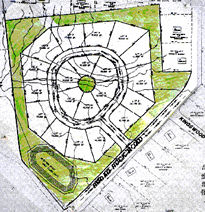 |
|||||||||||||||||
 |
|
||||||||||||||||
 Copyright 2007 LandChoices - All Rights Reserved To open portable document files (PDF) click below |
"Clustering" vs. conservation subdivision design
Cluster design vs. conservation subdivision design (PDF) Courtesy Anne Hutchinson, Natural Lands Trust Conservation Design Versus Typical Cluster Regulations "Conservation subdivision design differs from "clustering" in three important ways. First, it sets much higher standards for the quantity, quality, and configuration of the resulting open space. Where cluster ordinances typically require only 25 or 30 percent open space to be set aside, conservation subdivisions designate at least 40 percent (and usually 50 percent or more) of the land as permanent, undivided open space. Unlike most cluster provisions, this figure is based only on the acreage that is high, dry, flood-free, and not steeply sloped. Following this approach, a significant part of the community's important farmland or woodland resources (including terrestrial habitat) and its historic or cultural features can be protected." "Second, municipalities can exercise greater influence on the design of new conservation subdivisions. Rather than leave the outcome purely to chance, this flexible design approach can be strongly encouraged or even required where the Comprehensive Plan has identified the location of note-worthy resources. That encouragement could take the form of density bonuses for land-conserving design and could be combined with strong disincentives to actively discourage land-consuming layouts of large lots." "Third, the protected land is also configured so that it will, wherever practicable, contribute to creating an interconnected network of open space throughout the community, linking resource areas in adjoining subdivisions and/or providing buffers between new development and preexisting parklands, state forests, game lands, wildlife refuges, or land trust preserves." Above taken from "Growing Greener: Putting Conservation into Local Plans and Ordinances", Author-Randall Arendt. Natural Lands Trust. American Planning Association. American Society of Landscape Architects. 1999 Natural Lands Trust. Island Press. "Conservation subdivisions are thus distinct from the mere clustering of lots where environmental concerns, aesthetics, history, and culture are given relatively short shrift." Raymond Mohamed, Wayne State University, "The Economics of Conservation Subdivisions, Price Premiums, Improvement Costs, and Absorption Rates." Cluster image courtesy Tony Lachowicz, Planning and Zoning Consultant, RI |
||||||||||||||||
| Preserve Your Land | Conservation Subdivisions | Other Choices Home | About Us | News | Projects | Sponsors | Contribute | Contact Us | Links | Kids | Media Kit LandChoices • P.O. Box 181 • Milford, MI 48381 • info@landchoices.org Privacy Statement | www.landchoices.org |
|||||||||||||||||





